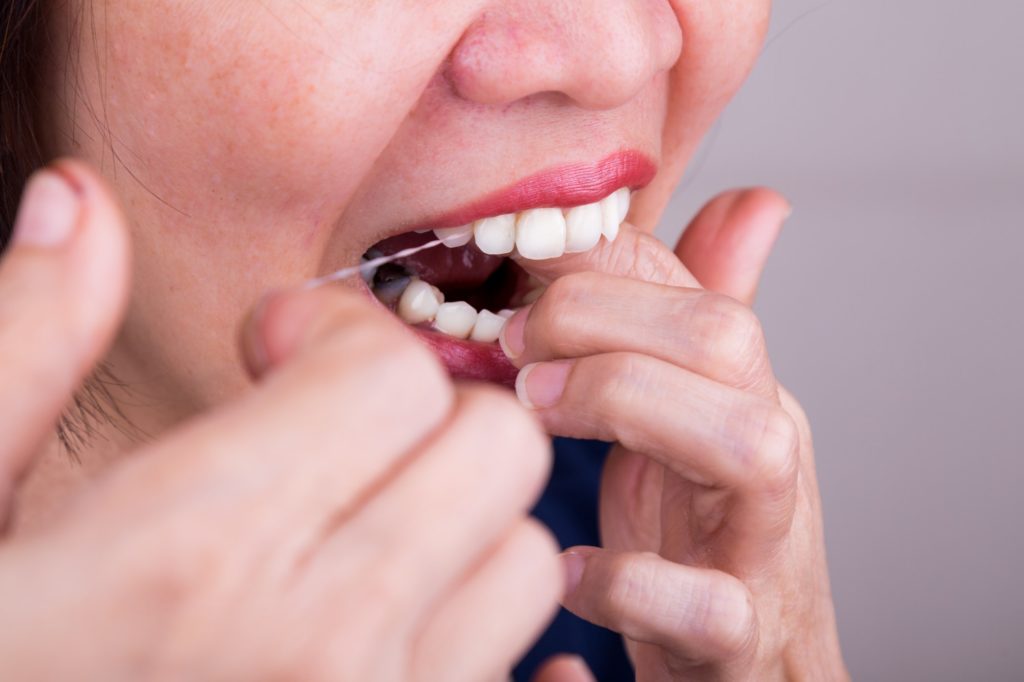Flossing is a Must for Good Oral Health

Did you know… the American Dental Association recommends cleaning between your teeth daily to help prevent cavities and gum disease. Cleaning between your teeth helps remove plaque – bacteria that feeds on leftover food or sugar in your mouth and cause cavities.
Table of Contents
Why is Flossing a Must For Good Oral Health?
There are a lot more reasons for using dental floss than for a simple one-off event, such as when a piece of popcorn gets stuck between your teeth. In fact, people have been using dental floss to clean the areas between their teeth and above their gum lines where a brush can’t reach since the early 19th century.
Flossing is essential for good oral health because it is vital to a well-rounded dental hygiene routine. While brushing is effective at cleaning the surfaces of teeth, it often can’t reach the tight spaces between teeth and below the gumline, where food particles and plaque accumulate. Neglecting these areas can lead to cavities, gum inflammation, and gum diseases like gingivitis and periodontitis. Flossing helps remove trapped debris and plaque from these hard-to-reach areas, preventing the development of dental issues.
Furthermore, general health and well-being are intimately related to good dental health. Systemic health concerns such as diabetes, respiratory disorders, and cardiovascular diseases have all been linked to poor dental hygiene Flossing plays a critical role in maintaining healthy gums and teeth, which can, in turn, contribute to better overall health. Therefore, it’s essential to incorporate flossing into your daily dental care routine to ensure comprehensive oral health and reduce the risk of dental and systemic health problems.
Can Flossing Help Prevent Diseases?
Periodontal diseases can arise due to a number of possibilities that include age, family history and other general conditions. A buildup of plaque bacteria under the gum line can lead to gingivitis, which is a minor periodontal disease. But if the gingivitis isn’t treated and cured, that minor periodontal issue can lead to a major issue, such as tooth loss.
Flossing is crucial in preventing gum diseases like gingivitis and periodontitis. Gum diseases are often caused by the accumulation of plaque, a sticky film of bacteria, on teeth and along the gumline. Frequent flossing aids in removing plaque and food particles from areas beneath the gum line and in between teeth that are difficult for toothbrushes to reach. Flossing significantly lowers the risk of gum inflammation and infection by reducing plaque buildup.
In addition, several systemic health conditions, including diabetes, heart disease, and respiratory disorders, have been connected to gum disease. Maintaining good oral hygiene through flossing can improve overall health and well-being. Complementing flossing with regular brushing and dental check-ups is essential to ensure comprehensive oral care and disease prevention.
When Should I Floss?
Properly using dental floss, in combination with regular brushing and best done prior to brushing, gets rid of plaque bacteria and debris that are lodged between teeth in places that your toothbrush just cannot reach. People who care about their teeth must include flossing as a part of their daily oral hygiene habits.
Check out 5 Steps to a Flawless Floss from the American Dental Association and this video below:
Source: American Dental Association
Floss FAQs
The sequence of flossing and brushing can vary based on personal preference, and both methods have advantages. Some dental professionals recommend flossing before brushing because it allows you to remove food particles and plaque from between teeth and below the gumline first. This clears the way for your toothbrush to clean the surfaces of your teeth effectively.
However, the most important factor is consistency in your oral hygiene routine. Whether you floss before or after brushing, the key is to do both regularly to maintain good oral health.
An abscessed toot can result from anything that makes it possible for bacteria to enter your tooth or the tissues around it. some causes are:
- Devastation of your tooth’s hard surface is known as a cavity (also known as tooth decay). When bacteria break down the sugars in food and drink, acid is produced that damages enamel.
- Teeth that are fractured, chipped, or cracked might have any opening filled with bacteria, which can then spread to the pulp.
- Periodontal disease, often known as gum disease, is an infection and inflammation of the gum and dental tissue. Bacteria are able to enter deeper tissues when gum disease worsens.
- Injury to the tooth: Even if there is no crack apparent, trauma to a tooth can nonetheless cause injury to the inner pulp. It is susceptible to infection because of the damage.
For each use, you typically only need 18 to 20 inches (45 to 50 centimeters) of dental floss. This length gives you enough floss to use a clean section between each tooth, preventing the transfer of debris and bacteria. Wind most of the floss around your middle fingers, leaving about 1-2 inches of floss to work with. Using the right amount of floss ensures effective cleaning without wasting it.
